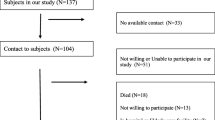Abstract
Objective
To compare arm span and height in body mass index (BMI) calculation in patients with spinal curvature and investigate their impact on interpretation of BMI.
Study Design
Prospective case-control cohorts.
Summary of Background Data
The BMI value is based on weight to height ratio. Spine deformity patients experience height loss and its use in calculating BMI is likely to produce errors. A surrogate for height should therefore be sought in BMI determination.
Methods
Ninety-three spine deformity patients were matched with 64 normal children. Anthropometric values (height, arm span, and weight) and spinal curve were obtained. BMIs using arm span and height were calculated, and statistical analysis performed to assess the relationship between BMI/height and BMI/arm span in both groups as well as the relationship between these values and Arm Span to Height difference (Delta AH).
Results
There were 46 males and 47 females, the average age was 15.5 years in Group 1 versus 33 males and 31 females, average age 14.8 years in Group 2. Major scoliosis in Group 1 averaged 125.7° (21° to 252°). The extreme curves show vertebral transposition, with overlapping segments making it more than 180°. A logistic regression showed that there was linearity in BMI scores (R2 = 0.97) for both arm span and height (R2 = 0.94) in group 2 patients. For group 1 patients there was a significant difference in the BMI values when comparing BMI/arm span versus BMI/height (p < .0001). Mean BMI values using height was overstated by 2.8 (18.6%). The threshold at which BMI score must be calculated using arm span as opposed to the height (Delta AH) was determined to be 3 cm.
Conclusions
Spine deformity patients experience height loss, which can impact their true BMI values thereby giving an erroneous impression of their nutritional status. The arm span should be used in patients with Delta AH >3 cm to properly assess nutritional status.
Similar content being viewed by others
References
Weber DR, Leonard MB, Zemel BS. Body composition analysis in the pediatric population. Pediatr Endocrinol Rev 2012;10:130–9.
Ibegbu A, Tosin D, Hamman W, et al. Nutritional evaluation using different anthropometric variables in Nigerian school children. J Exp Clin Anat 2013;12:42–9.
Lee SY, Gallagher D. Assessment methods in human body composition. Curr Opin Clin Nutr Metab Care 2008;11:566–72.
Orden AB, Bucci PJ, Petrone S. Trends in weight, height, BMI and obesity in schoolchildren from Santa Rosa (Argentina), 1990–2005/07. Ann Hum Biol 2013;40:348–54.
Sultana T, Karim MN, Ahmed T, et al. Assessment of under nutrition of Bangladeshi adults using anthropometry: can body mass index be replaced by mid-upper-arm-circumference? PLoS One 2015;10: e0121456.
Pettersson U, Nordstrom P, Alfredson H, et al. Effect of high impact activity on bone mass and size in adolescent females: a comparative study between two different types of sports. Calcif Tissue Int 2000;67:207–14.
Ashwell M, Gibson S. Waist-to-height ratio as an indicator of “early health risk”: simpler and more predictive than using a “matrix” based on BMI and waist circumference. BMJ Open 2016;6: e010159.
WHO Multicentre Growth Reference Study Group. WHO Child Growth Standards: Length/height-for-age, weight-for-age, weight-for-length, weight-for-height and body mass index-for-age: Methods and development. Geneva: World Health Organization; 2006. Available at: http://www.who.int/childgrowth/standards/technical_report/en/index.html. Accessed December 4, 2017.
Monyeki KD, Sekhotha MM. The relationships between height and arm span, mid-upper arm and waist circumferences and sum of four skinfolds in Ellisras rural children aged 8–18 years. Public Health Nutr 2016;19:1195–9.
Datta Banik S. Arm span as a proxy measure for height and estimation of nutritional status: a study among Dhimals of Darjeeling in West Bengal India. Ann Hum Biol 2011;38:728–35.
Karadag B, Ozturk AO, Sener N, et al. Use of knee height for the estimation of stature in elderly Turkish people and their relationship with cardiometabolic risk factors. Arch Gerontol Geriatr 2012;54:82–9.
Supare MS, Bagul AS, Pandit SV, et al. Estimation of stature from arm span in medical students of Maharashtra, India. Ann Med Health Sci Res 2015;5:218–21.
Quanjer PH, Capderou A, Mazicioglu MM, et al. All-age relationship between arm span and height in different ethnic groups. Eur Respir J 2014;44:905–12.
de Lucia E, Lemma F, Tesfaye F, et al. The use of armspan measurement to assess the nutritional status of adults in four Ethiopian ethnic groups. Eur J Clin Nutr 2002;56:91–5.
Mohanty SP, Suresh Babu S, Sreekumaran Nair N. The use of arm span as a predictor of height: a study of South Indian women. J Orthop Surg 2001;9:19–23.
Gavriilidou NN, Pihlsgard M, Elmstahl S. High degree of BMI misclassification of malnutrition among Swedish elderly population: age-adjusted height estimation using knee height and demispan. Eur J Clin Nutr 2015;69:565–71.
Liu JS, Dong C, Vo AX, et al. Obesity and anthropometry in spina bifida: what is the best measure. J Spinal Cord Med 2016:1–8.
Reeves SL, Varakamin C, Henry CJ. The relationship between arm-span measurement and height with special reference to gender and ethnicity. Eur J Clin Nutr 1996;50:398–400.
Kwok T, Whitelaw MN. The use of armspan in nutritional assessment of the elderly. J Am Geriatr Soc 1991;39:492–6.
Chumlea WC, Guo SS, Wholihan K, et al. Stature prediction equations for elderly non-Hispanic white, non-Hispanic black, and Mexican-American persons developed from NHANES III data. J Am Diet Assoc 1998;98:137–42.
Lahner CR, Kassier SM. Veldman. Estimation of true height: a study in population-specific methods among young South African adults. Public Health Nutr 2017;20:210–9.
Author information
Authors and Affiliations
Consortia
Corresponding author
Additional information
IRB Approval Statement: This study has been approved from the Intitutional Review Board (IRB) of the Noguchi Memorial Institute, University of Ghana Legon Accra Ghana.
Author disclosures: HO (none); TY (none); BOO (none); OBA (grants, personal fees and other from K2M, other from WEIGAO, outside the submitted work); FOCOS Spine Research Group (none).
Rights and permissions
About this article
Cite this article
Opoku, H., Yirerong, T., Osei-Onwona, B. et al. The Use of Arm Span as a Substitute for Height in Calculating Body Mass Index (BMI) for Spine Deformity Patients. Spine Deform 6, 220–225 (2018). https://doi.org/10.1016/j.jspd.2017.09.052
Received:
Accepted:
Published:
Issue Date:
DOI: https://doi.org/10.1016/j.jspd.2017.09.052




